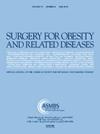单吻合术十二指肠回肠旁路加袖胃切除术治疗糖尿病:一项多中心研究中缓解和代谢结果的预测因素。
IF 3.8
3区 医学
Q1 SURGERY
引用次数: 0
摘要
背景:单吻合术十二指肠回肠旁路与套筒胃切除术(SADI-S)结合了套筒胃切除术(SG)的限制性方面和胃旁路术的低吸收优势。SADI-S已经证明了良好的减肥效果和技术可行性。目的:评价SADI-S对肥胖合并2型糖尿病患者的治疗效果。环境:美国的学术和私人执业医院。方法:经机构审查委员会(IRB)批准,对2013年1月1日至2023年4月1日期间接受SADI-S治疗的成年肥胖和2型糖尿病患者进行多中心回顾性评价。2型糖尿病缓解定义为血红蛋白A1C (HbA1C)值。结果:共确定了419例连续患者,中位年龄为50.0岁(四分位数间距[IQR] 17),平均体重指数(BMI)为47.1±8.9 kg/m2。总体重减轻的平均百分比(%TWL)为31.9%,2型糖尿病缓解率为60.1%,平均随访时间为2.0年。最终分析纳入226例患者。术前胰岛素使用和较高的BMI是2型糖尿病缓解的负向预测因子,而较高的TWL与最后一次随访时2型糖尿病缓解的可能性较高相关。平均而言,患者维持较低的HbA1C值。结论:SADI-S是一种治疗肥胖和2型糖尿病患者的有效且持久的代谢和减肥手术(MBS)。术前BMI和胰岛素使用较高的患者术后2型糖尿病缓解的可能性较小。本文章由计算机程序翻译,如有差异,请以英文原文为准。
Single-anastomosis duodenal-ileal bypass with sleeve gastrectomy for diabetes: predictors of remission and metabolic outcomes in a multicenter study
Background
The single-anastomosis duodenal-ileal bypass with sleeve gastrectomy (SADI-S) combines the restrictive aspects of a sleeve gastrectomy (SG) with the hypoabsorptive advantages of a gastric bypass. SADI-S has demonstrated excellent weight loss outcomes and technical feasibility.
Objectives
To evaluate the benefits of SADI-S in patients with obesity and type 2 diabetes mellitus.
Setting
Academic and private practice hospitals, United States.
Methods
Following the institutional review board (IRB) approval, a multicenter retrospective review was conducted to evaluate adult patients with obesity and type 2 diabetes who underwent SADI-S between January 1, 2013, and April 1, 2023. Type 2 diabetes remission was defined as a hemoglobin A1C (HbA1C) value of <6.5% in the absence of any antidiabetic medication use. Patient demographics and bariatric and metabolic-related parameters were collected.
Results
A total of 419 consecutive patients were identified with a median age of 50.0 years (interquartile range [IQR] 17) and a mean body mass index (BMI) of 47.1 ± 8.9 kg/m2. The mean percentage of total weight loss (%TWL) was 31.9% with a type 2 diabetes remission rate of 60.1% and a mean follow-up period of 2.0 years. Two hundred twenty-six patients were included in the final analysis. Preoperative insulin use and higher BMI were negative predictors of type 2 diabetes remission, whereas greater %TWL was associated with a higher likelihood of type 2 diabetes remission at the last follow-up. On average, patients maintained reduced HbA1C values.
Conclusions
SADI-S is an effective and durable metabolic and bariatric surgery (MBS) for patients with obesity and type 2 diabetes. Patients with higher preoperative BMI and insulin use are less likely to experience type 2 diabetes remission after surgery.
求助全文
通过发布文献求助,成功后即可免费获取论文全文。
去求助
来源期刊
CiteScore
6.70
自引率
12.90%
发文量
570
审稿时长
56 days
期刊介绍:
Surgery for Obesity and Related Diseases (SOARD), The Official Journal of the American Society for Metabolic and Bariatric Surgery (ASMBS) and the Brazilian Society for Bariatric Surgery, is an international journal devoted to the publication of peer-reviewed manuscripts of the highest quality with objective data regarding techniques for the treatment of severe obesity. Articles document the effects of surgically induced weight loss on obesity physiological, psychiatric and social co-morbidities.

 求助内容:
求助内容: 应助结果提醒方式:
应助结果提醒方式:


